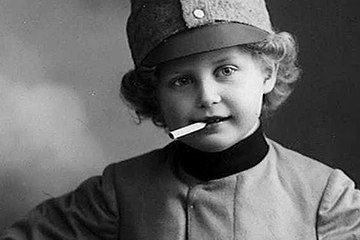The First World War as reflected in the distortions of caricature
Caricature was especially successful as a medium of propaganda since its subtle visual effects could have a substantial and far-reaching impact, ensuring the swift dissemination of emotions and values in reaction to current events.
With the rise of the illustrated sensational press at the beginning of the twentieth century, the press image acquired a decisive importance in the mediation of news and events. The same period also saw the heyday of the caricature in the daily and weekly press and satirical publications. With the outbreak of war and under pressure from the censorship authorities, most caricaturists turned away from their mocking criticism of the domestic political scene to toe the governmental propaganda line. Caricatures performed the function of mobilizing the population for the war, encouraging them to persevere and carry on, and of reinforcing enemy stereotypes.
Exaggeration, generalization and a clearly discernible bias (derogatory or glorifying, aggressive, humorous, etc.) are the defining stylistic elements of caricature. Generally caricatures consisted of an exaggerated pictorial image frequently accompanied by short text passages. The interplay between image and text conveyed a clear message that mostly referred to a specific event and reflected the subjective opinion of the artist. As the ‘eye-catcher’ of propaganda, caricaturists relied on the readers’ powers of association. The blurred line between truth and illusion was deliberately deployed as a stylistic device.
Atrocity caricatures and inflammatory images vilified the enemy states. Furnished with negative attributes and belittled through exaggeration, they were held up to ridicule. Stereotypical images of enmity were based on long-established clichés and frequently referred to actual individuals at whom hatred for the enemy was projected. Especially popular were figures from public life who had an unprepossessing physiognomy. A typical example of this was the way in which the British foreign minister Sir Edward Grey was portrayed in German-language cartoons.
Frequently they enemy was represented by symbolic national figures, Germania embodying the German Empire, Austria the Austria-Hungarian Monarchy, John Bull personifying England, Marianne standing for France and Uncle Sam for America. Nations were also represented as animals: Britain appearing in the guise of a bulldog, France lampooned as a cockerel, Italy symbolized as a snake, Japan as a monkey and Russia represented as a bear. Austria-Hungary appeared as a double-headed eagle while Germany was portrayed as the Hohenstaufen eagle. Through repeated use of these images they became a sort of short-hand reference for the respective nations.
Translation: Sophie Kidd
Demm, Eberhard (Hrsg.), Der Erste Weltkrieg in der internationalen Karikatur, Hannover 1988
Demm, Eberhard Karikaturen aus dem Ersten Weltkrieg. Eine Ausstellung des Bundesarchivs, Koblenz 1990
Tomenendal, Kerstin: Das Türkenbild in Österreich-Ungarn während des Ersten Weltkrieges im Spiegel der Kriegspostkarten, Klagenfurt/Wien/Ljubljana 2008
Topitsch, Klaus: Die Greuelpropaganda in der Karikatur, in: Zühlke, Raoul, Bildpropaganda im Ersten Weltkrieg, Hamburg 2000, 49-92
Vocelka, Karl: K. u. k.: Karikaturen u. Karikaturen zum Zeitalter Kaiser Franz Josephs, Wien/München 1986
-
Chapters
- Propaganda: psychological warfare in the First World War
- The battle for hearts and minds.
- Friend and foe – guilt and innocence in First World War propaganda
- “Let your hearts beat for God and your fists beat the enemy”
- The First World War as reflected in the distortions of caricature
- The war on the wall
- Truth from the clouds
- The Emperor’s Voice
- Tones and Sounds







